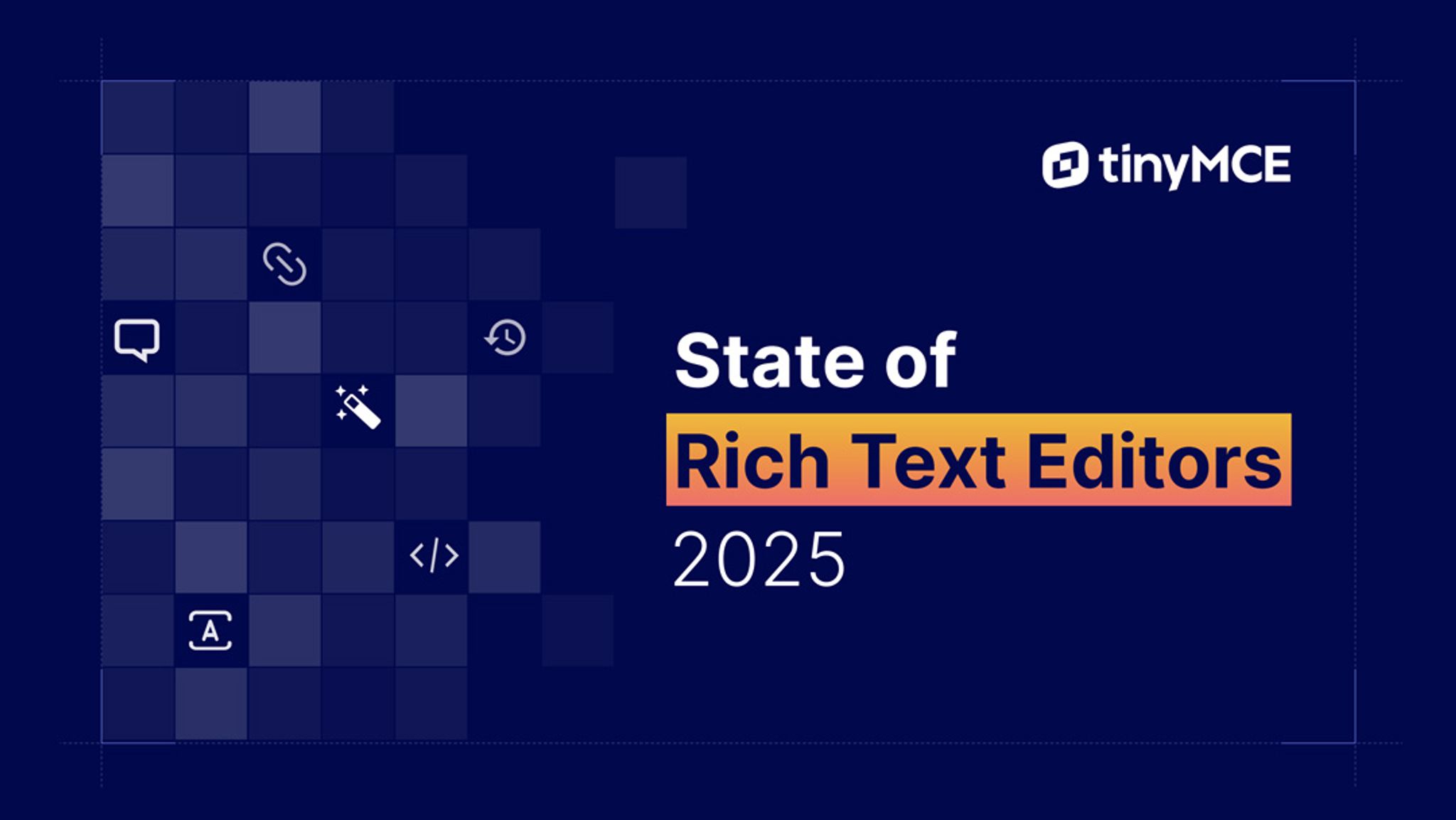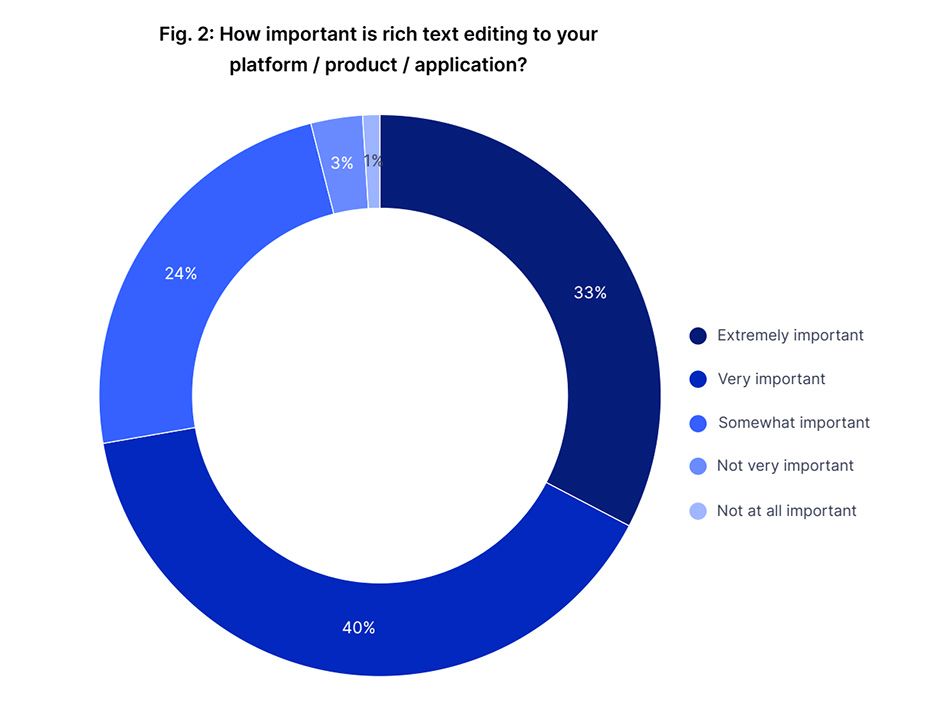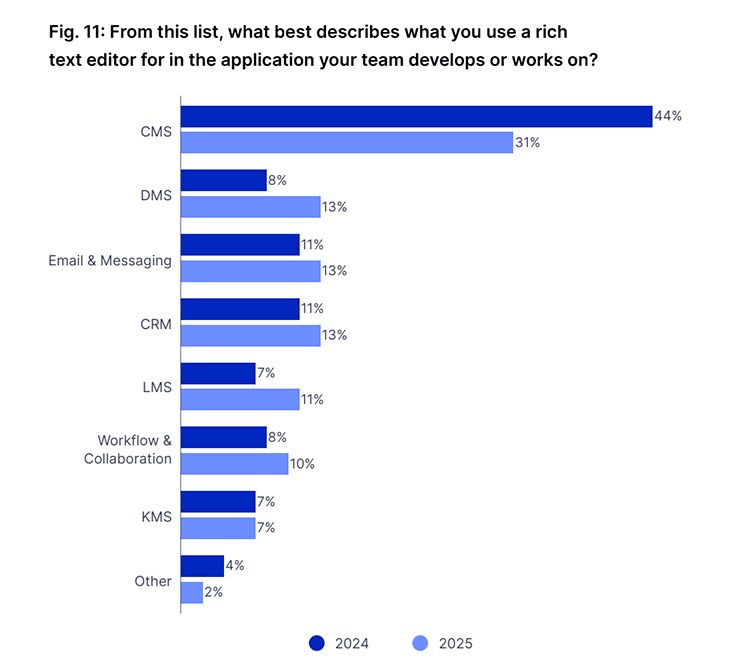TinyMCE releases 2025 ‘State of Rich Text Editors’ report, and CMS use cases are fading. Why it matters

According to the survey data, RTE decisions are becoming more strategic as expectations shift from simple text editing to intelligent, secure, and highly flexible tools with AI capabilities. Meanwhile, CMS use cases have declined as DMS and other categories notch increases.
When I recently spoke to Tiugo Technologies’ new CFO Andrew Iappini, we discussed how the company plans to invest in AI capabilities and the broader consolidation trend across developer tools.
He had only been on the job for a month – not enough time to build fluency around all the products Tiugo has amassed in its platform, including ButterCMS, Uploadcare, and CKEditor. But he has a vision, and it’s focused on AI and enriching the developer experience, something he knows about from his time at the video streaming and monetization platform JWP Connatix.
"I had experience in end markets where we were selling to developers, and I think one of the things that I was interested in was a company that was exposed to positive, secular trends,” he said, outlining the reasons for his move to Tiugo. He sees AI as a catalyst for scaling developers, and Tiugo as an opportunity to scale on the same upward trajectory.
We also talked about Tiugo’s unique strategy in the market as an umbrella for assembling a complementary collection of global, API-first developer tools that help users and organizations build better products via content creation, management, and collaboration.
To be clear, Tiugo isn’t a DXP, even if the sum of the parts is composing some manner of a whole. At best, it shares some unique structural similarities to QNTM’s portfolio of martech solutions (including Ibexa), but curates a spate of complementary developer-centric tools. As part of its strategy, it acts the part of a PE managing a portfolio of B2B growth companies, providing a “playbook for growth” to its managed brands.
For Tiugo, there are already a few foundational components forming its posture. Headless CMS is one, file uploading and processing another. But there’s also the presence of the essential rich text editor (RTE), which has long been an elemental fixture of enterprise software platforms.
Case in point: RTEs have been essential to every CMS on the planet, powering the WYSIWYG experience for a wide variety of features like content editing and custom module functionality. One might say they’re the “unsung heroes” of content operations, and that their simplicity and elegance can make or break the editing experience.
Tiugo’s TinyMCE has been a de facto standard in the RTE pantheon. I’ve used it in different use cases and marveled at how robust it has become over the years. Originally spun out of the Moxiecode content editor (a sort of proto-CMS) in 2004, it now sports integrations and APIs for a wide variety of apps and frameworks, including premium features like a revision history, media optimizer, accessibility checker, and even an AI assistant.
How popular is it? With more than 350 million downloads each year and over 100 million products using TinyMCE, it’s nearly ubiquitous – even if you’ve never heard of it. And that’s the beauty of an RTE that’s highly performant: developers can integrate and customize these workhorses around a myriad of use cases with total confidence.
The development landscape is changing
It's true, and I've spoken about this at several conferences. On one hand, developer jobs are disappearing – and wayward practitioners are creating a flood of new GitHub repos with a penchant for Python and a need for open source tools and frameworks for building apps. At the same time, AI is making it faster and easier to vibe code all kinds of things into existence, including app components like custom WYSIWYGs.
Even if the idea of building your own is more attainable, modern RTEs are becoming richer and more complex, which makes performance and compliance more difficult to assure. As such, building and maintaining your own editor could impact your velocity and time to ship, and it might not be worth the risk. There's clearly some tension here.
So what’s really going on in this niche corner of the developer ecosystem? And how is it impacting CMSes specifically?
Each year, TinyMCE conducts an annual survey to answer these questions (and more). Recently, it published its fifth annual 2025 State of Rich Text Editors report, and there’s a big shift in motion: CMS use cases, which have been a bread-and-butter channel for RTEs, are on the decline – even as basic text editing expectations have evolved to AI-driven, secure, and composable tools.
TinyMCE conducted its survey in the second quarter of 2025 in partnership with DO FEEL THINK, a reputable strategy and consulting firm that works with the likes of Spotify. The sample size included 534 technical professionals – from full-stack pros to DevOps practitioners to marketing professionals – who develop or manage rich text editors in their applications.
The survey participants reflected a diverse range of technologists using RTEs within their own solutions across a wide range of products and custom-built editor platforms. This included free, open source, and commercial software applications, and encompassed both single developers and enterprise teams working on individual and organizational projects.
There’s a lot of great data in this survey. Let’s zoom in on the tiny stuff and see what stands out.
So what did this year’s survey reveal?
Simply put: While RTEs are still important to all participants, they were framed as “nearly indispensable” tools at the enterprise level. Digging a little deeper, there’s strong evidence to support how scale-ups are increasingly dependent on performant, reliable, and feature-rich content tools. This makes the choice of an RTE less of a technical consideration and more of a strategic imperative.
Perhaps the biggest point of transformation from last year’s report was the emphasis on AI. It shifted from a “future possibility” to a “baseline expectation,” with 20% of respondents asking for AI to serve as a full collaborator and 42% noting AI collaboration as the most crucial RTE advancement for the next five years.
What are users demanding from AI in the RTEs? A partner in the creative process, providing brainstorming, writing, and ideating features built directly into the tool. As one respondent noted, “We’re integrating with AI-driven workflows, and the ability for users to collaborate live on AI-generated drafts is becoming more and more of a requirement."

Source: TinyMCE 2025 State of Rich Text Editors report
The report establishes a solid foundation for the critical nature of rich text editors, with 73% (a 33% and 40% split) of respondents rating them as extremely or very important. Customization is also vital to delivering the right user experience, with 40% of participants acknowledging that they have modified the UI of their RTE to meet the specific needs of their app.
The data also digs into the proactiveness of maintenance, as well as the languages and frameworks that are leading the way (PHP is still king, but JavaScript is a close second). It’s worth noting that at the enterprise level, the tech stack diversifies with Python, C++, and TypeScript dominating the mix. This reflects the deeper needs of data science, large-scale frontend apps, and the emergence of AI functions.

Source: TinyMCE 2025 State of Rich Text Editors report
Like many organizations, composability is key – and different teams use different tools. To that end, 55% of the survey respondents admit to using more than one RTE in apps across their company, and that decentralization grows in lockstep up the enterprise. Above 10,000 employees, the trend reverses, with fewer editors being used. This reflects a more cohesive standardization with mature, large-scale operations.
Deployment options are also an interesting data point, with self-hosted and cloud representing the largest segments. As you might guess, regulated industries are gravitating towards a self-hosted footprint to maintain control and confidence, but hybrid models are also growing in popularity.
Security is a top consideration when selecting an RTE
As stated, the data is revealing just how strategic this decision is, as it impacts the long-term costs of integration, maintenance, and scalability. As part of the evaluation journey, the survey zoomed in on three key areas of consideration: ease of implementation, technology support, and overall features.
From a feature perspective, security is the top concern among respondents. 79% said it was the central issue, followed by performance (77%), customizability (71%), and framework integration (65%).
All were identified as “non-negotiables” for any modern RTE.
When it comes to the prioritization of factors, ease of implementation wins out, with 52% of participants echoing that sentiment. Overall stability is key, and having the blend of capabilities falls into the top five considerations. But reducing friction via “quick setup” or no-frills, open source licensing has become an elevated target.

Source: TinyMCE 2025 State of Rich Text Editors report
There’s some data in the report that shines a light on the question of switching or replacing editors – which, in almost any use case, ain’t easy. Key pain points are driving this: 21% say a lack of features, while 19% cite the overall cost.
But much of the angst is coming from a shift towards composable architectures. Teams are no longer willing to “work around” a component that slows down or hinders their progress. Breaking apart monolithic dependencies is a contributing factor, and one reason why 22% of respondents said they are “very likely” to switch their editor in the next two years.
Build or buy? That is the question
As I mentioned already, organizations are wrestling with the classic “build or buy” dilemma surrounding their RTE strategies. The decision is a critical one, with long-term consequences for cost, resources, and technical debt.
According to this year’s research, some growing trends have emerged: 60% of organizations are now opting to buy a third-party RTE, a three-point jump from 2024. In contrast, 30% are building their own in-house, reflecting a seven-point jump from the previous year.

Source: TinyMCE 2025 State of Rich Text Editors report
As the report concludes, there’s an interesting balance at play. With building comes deeper control and, of course, ownership. But that can obscure the total cost of what becomes a heavy, ongoing engineering project. RTEs are not simple components; they have evolved to become complex, AI-imbued applications that require ongoing maintenance. And of course, there are palpable risks when it comes to security, privacy, and compliance.
For small-to-mid-sized organizations, this could stymie velocity and time to market, and the case to buy becomes more compelling. Interestingly, enterprises see the opposite polarity: 36% cite concerns surrounding security in ready-made editors, and 34% are attracted to the flexibility associated with building versus buying.
Of course, the reality of building an RTE is another story. 23% of respondents said it took longer than expected, while 19% admitted it cost more than they thought. Given those realities, enterprises might weigh the pros and cons a little differently.
Is this the ‘dethroning’ of CMS use cases?
For years, content management systems have been the primary use case for RTEs. This year’s data reveals a crack in the crown: While CMS still remains on top, its dominance has eroded, falling from 44% in 2024 to just 31% this year.
That’s a significant drop by any measure. And while this is a relatively small sample, it’s indicative of some larger trends and “prevailing winds.” First, the CMS vertical is mature and saturated, and there continues to be a gradual evolution of ecosystem tools that cover more of the content creation supply chain. As such, fewer new CMSes are emerging into the market, and less centralized functionality that might require RTEs in predictable places.

Source: TinyMCE 2025 State of Rich Text Editors report
There’s also something else happening here. As the data reflects, every other category moved up from the previous year – with the exception of knowledge management systems (KMS), which remained flat. In particular, document management systems (DMS) saw the most notable growth, jumping 5 points since 2024.
As the report surmises, this trend could point to a “great unbundling” of content creation, where functions that were previously part of a CMS are now shifting to modular, purpose-built platforms like document management, training, and collaboration.
Security is also igniting demand for self-hosted DMS solutions. As companies seek to control vital and often regulated assets like invoices, contracts, and reports, some are migrating away from cloud-based SaaS systems and into secure, managed environments where secure RTEs are paramount.
Will this trend away from CMS continue? There are a confluence of factors at play, but regardless of the use case or specific workflows, having a flexible, secure, and adaptable RTE will be crucial as emerging technologies like AI reshape the content management landscape.
What’s next and why it matters
Back in 2023, I interviewed Tiny’s nascent GenAI team, who were spearheading the integration of OpenAI with TinyMCE in its first use case. For CMSes that were already “tinyfied” (an internal moniker the company uses to denote a TinyMCE integration), this was designed to help accelerate content generation within platforms and the editing workflow.
In those days, new headless CMSes were rolling into the market on an almost daily basis, all leveraging rich text editors in myriad places. But fast forward to 2025, and it’s a different landscape – one where CMS platforms are fully transforming to become agentic studios with native AI capabilities. On top of that, the future of AI in the editor is no longer just about making writing easier; it’s about making the entire creation process fundamentally more powerful and dynamic.
The shift in CMS use cases is just one of the many trends altering the fabric of the RTE ecosystem. That’s why I got a lot out of TinyMCE’s State of Rich Text Editors report. For those of us who utilize these tools, it’s a fascinating glimpse into a foundational world of a niche technology used by millions but rarely featured in the spotlight. RTEs are workhorses of content-centric platforms, and this research is a snapshot into the ubiquity of these products and how their market of users perceives their importance.
With several years of research under the belt, we now have some persistent data to divine trends – and several stick out in the 2025 report. First and foremost, the dominance of AI is undisputable, and developers and teams expect their RTEs to incorporate specific features that make editors more useful and extensible.
Security is clearly “job zero” up and down the respondent cohort and reflects the concerns that exist on all sides of the equation, from build to buy. While some organizations might have the resources to build their own solutions, the preference towards third-party solutions highlights the importance of maintenance, compliance, and other benefits that help ensure performance at scale.
The shrinking primacy of CMSes in Tiny’s report isn’t a shocker, but there’s more here than just a conscious decoupling. The category is mature, and existing platforms are reinvesting in innovation over acquisition as AI becomes more of the central nervous system. It stands to reason that more enterprise-grade tools will feature home-grown interfaces, but downstream players will likely continue to rely on performant RTEs to maintain velocity. Still, I would envision more of those might eventually build their own tooling.
There's also the rise of open source solutions like TipTap, which provides out-of-the-box advantages – namely around licensing and cost. TipTap in particular offers a modular extension library with lots of custom options, as well as over 100 core and paid versions in its ecosystem. Recently, Umbraco shifted from TinyMCE to TipTap as part of its version 17 package, validating that some CMS use cases might be weighing the potential opportunities of open source.
Tomorrow’s RTE users crave choice and composability. They don’t want to compromise or work around the challenges of monolithic systems within systems. For providers like TinyMCE, the promised land rests with intelligent, lean, customizable, AI-ready solutions that are simple by design. They need to accelerate the shipping of software and deliver real value over time.
As a daily CMS user and a product builder, the editing experience is everything. I'm using one right now as I type this, and I can't underscore the importance of these tools. This is where TinyMCE excels with innovation and focus on its core product. And that reflects in its performance.
As Tiny observed in the report, the best RTEs put developers first, freeing them to focus on their own customers and empowering creators to do what they have always done: unleash the power and creativity of their content.
You can download the report here.
Upcoming Events

CMS Kickoff 2026
January 13-14, 2026 – St. Petersburg, FL
Meet industry leaders at our fourth annual CMS Kickoff – the industry's premier global CMS event. Similar to a traditional kickoff, we reflect on recent trends and share stories from the frontlines. Additionally, we will delve into the current happenings and shed light on the future. Prepare for an unparalleled in-person CMS conference experience that will equip you to move things forward. This is an exclusive event – space is limited, so secure your tickets today.